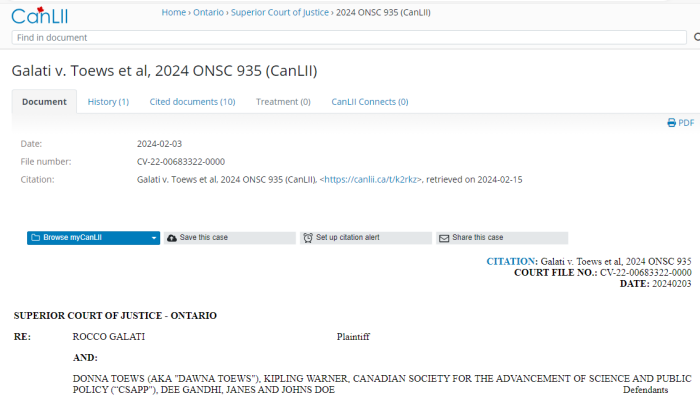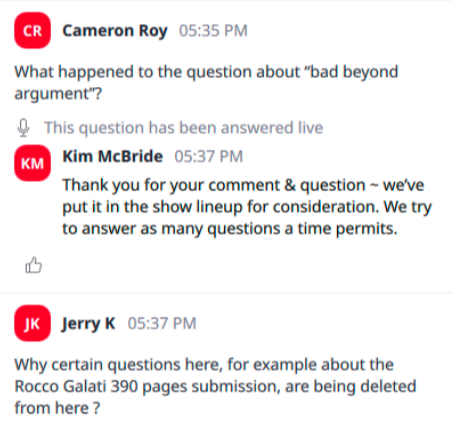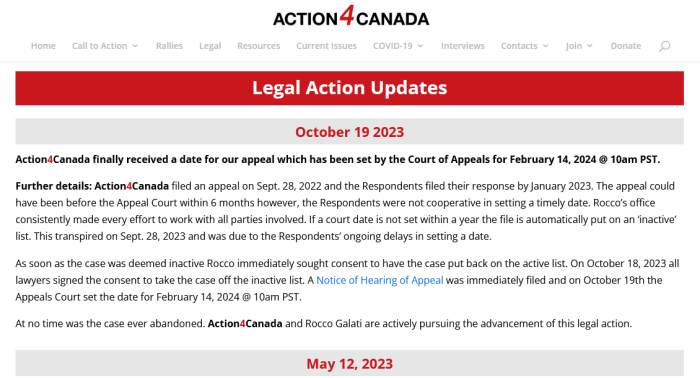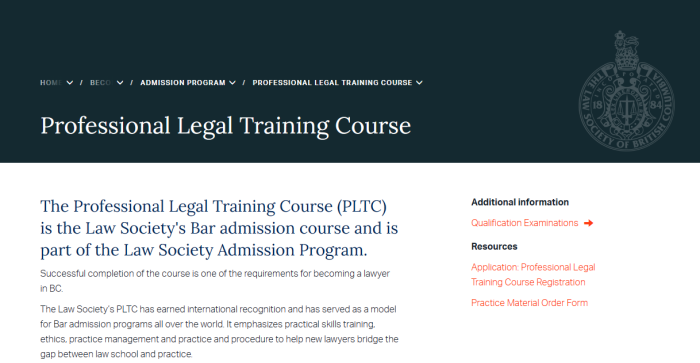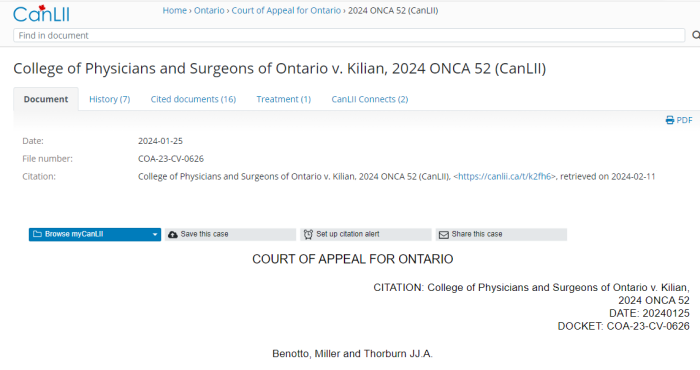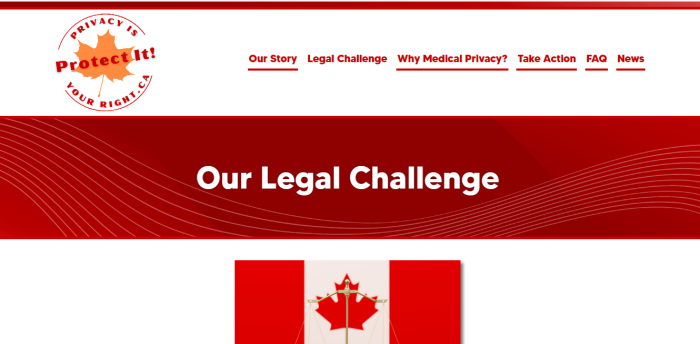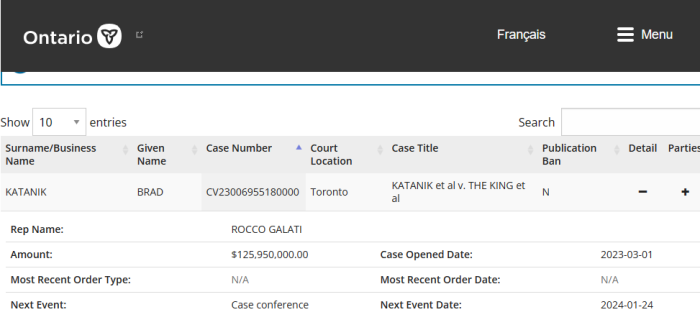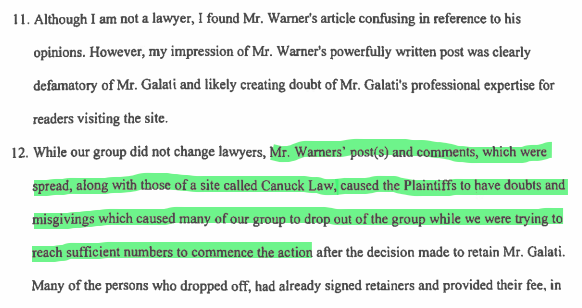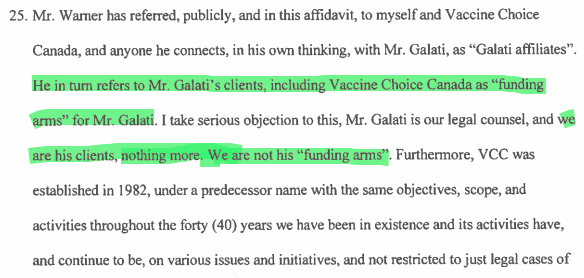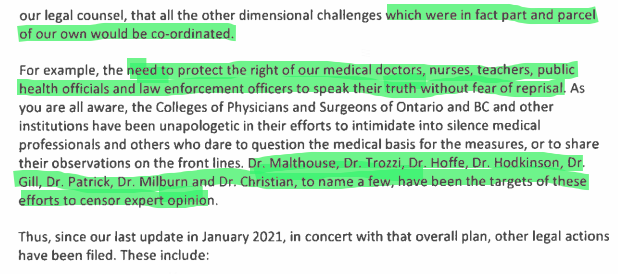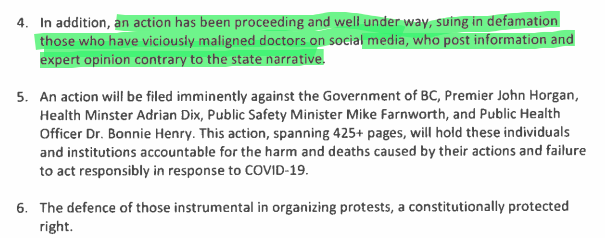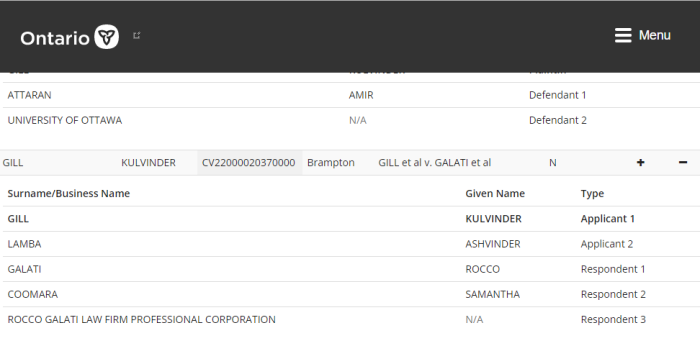
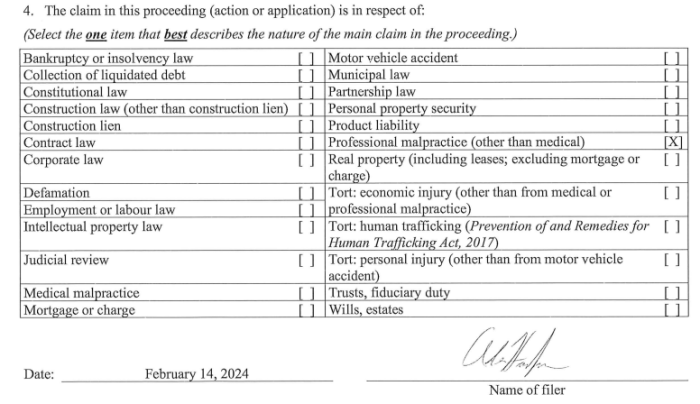
A $600,000 lawsuit was filed in Ontario Superior Court by an Ontario doctor who says that her former counsel was incompetent and negligent to the point that she’s suffered damages. She claims that the representation fell far below what should be considered professional. Specifically the Claim cites:
- professional negligence
- breach of fiduciary duty
- breach of contract
- incompetence
- conflict of interest
Kulvinder Kaur Gill and Ashvinder Kaur Lamba, both Ontario doctors, made headlines in 2020, filing a $12.75 million defamation lawsuit against 23 parties. It was primarily over petty online drama, and predictably, it was thrown out. The case was appealed, to the Ontario Court of Appeal. Soon afterwards, their lawyer, “Mr. Bad Beyond Argument”, abandoned them. This was allegedly over prolonged health issues.
Asher Honickman went on to represent Lamba in 2022. It’s interesting, since he’s also the one to commence proceedings against her former lawyer.
One of the main points of contention is that Gill and Lamba should never have joined their cases. While Gill alleged defamation from 23 parties, Lamba only had isses with 2 of them (Angus Maciver and Nadia Alam). Even then, she never really had a case against one of them. It’s argued in this malpractice suit that the asymmetry led to Lamba getting dragged into something much larger than she wanted.
Due to deficiencies in the original suit, it’s pleaded that Lamba wants damages from all 23 Defendants, even though she admittedly had nothing to do with 21 of them.
Also in this suit, Lamba claims she was never properly advised about the cost consequences — full indemnity (or 100%) — which are typical if they’re dismissed under anti-SLAPP laws.
There are many more problems to cover, and we’ll get into that. But first:
Pre-2020: Gill and Lamba have prior issues with Maciver and Alam. These predate the “pandemic” and the debate over lockdown measures.
Summer/Fall of 2020: Kulvinder Gill gets into many trivial arguments on Twitter, leading to some harsh replies. These are screenshotted to use as evidence.
December 2020: Gill and Lamba, sued 23 individuals and organizations for defamation. This was primarily (although not entirely) brought over Twitter spats that Gill had engaged in.
September 2021: Over the course of 3 days, several anti-SLAPP Motions are argued before Justice Stewart in the Superior Court. These are Motions to dismiss, based on Section 137.1 of the Courts of Justice Act. This is a section of the law that allows for rapid screening of lawsuits brought to “stifle public interest speech”.
February 2022: Justice Stewart dismisses the suit was dismissed under Ontario’s anti-SLAPP laws. This wasn’t at all surprising to anyone who understands defamation law. It was an extremely weak case. At this point, costs have yet to be determined.
March 2022: The lawyer for Gill and Lamba files a Notice of Appeal, despite the fact that he doesn’t intend to stick around. It also becomes apparent that counsel doesn’t fully understand the purpose of anti-SLAPP laws, nor the standards applied.
May 2022: Counsel for Gill and Lamba succeeds in getting himself removed from the case for “health reasons”. This come despite him actively being involved in other litigation, and even commencing other lawsuits.
July 2022: Gill and Lamba (with new counsel) try to get new cost submissions filed. They claim that their previous lawyer didn’t do anywhere close to an adequate job.
September 2022: The Appeal is “perfected” meaning all the documents are submitted. Note: there still hasn’t been an award of costs yet for the original decision from February.
October 2022: Gill and Lamba are hit with $1.1 million in legal costs from the Defendants, who were successful in getting the case thrown out. But to be fair, Gill took the bulk of the hit. She had sued all 23 Defendants, while Lamba was only pursuing a case against 2 of them.
October 2023: One of the Respondents, the Pointer Group Inc., argues a Motion that Gill should have to pay her costs up front, given how weak the Appeal is.
November 2023: The Motion for security for costs is denied.
December 2023: After many delays, the Appeal is finally heard, but with only a few Respondents left. Most have cut some sort of deal to accept partial payment.
February 2024: The Court of Appeal for Ontario throws out the Appeal against the few remaining Respondents who hadn’t yet settled over this.
Now, what other problems are alleged in this malpractice suit?
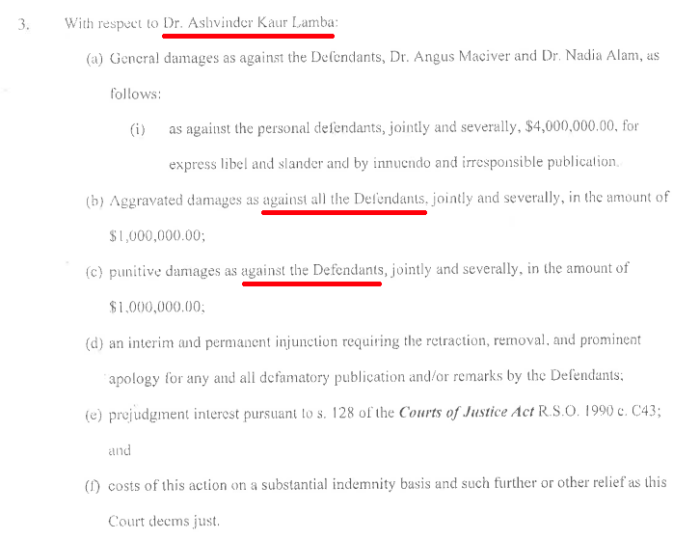
This is from page 7 of the Statement of Claim. Even though Lamba is pursuing defamation claims from just 2 of the Defendants (Gill from all 23), she seeks aggravated and punitive damages from everyone. This is a horribly amateurish error to make. These damages make up $2 million dollars, and it’s demanded that people who aren’t alleged to have wronged her have to pay.
This is the problem with the cut-and-paste lawsuit business. Important proofreading like this gets overlooked.

From page 81 of the Statement of Claim, it’s alleged that all the Defendants are liable to both Gill and Lamba for: (a) libel and slander; (b) conspiracy; (c) negligence; and (d) breach of professional obligations.
But, as stated earlier, Lamba had nothing to do with 21 out of the 23 Defendants. Her only stated grievances were with Maciver and Alam. The poorly worded Claim doesn’t distinguish that though.
What else is there?
Paragraph 17(d) the Claim reads that Lamba didn’t produce any evidence. By this, it means that she never submitted a sworn Affidavit against the anti-SLAPP Motions.
That matters because the 3rd branch of the anti-SLAPP test requires that the Plaintiffs submit evidence of at least some damages. While it doesn’t have to be a “fully developed brief”, there has to be something for a Judge to conclude that damages occurred.
By failing to do this, it’s guaranteed that the case would be thrown out.
Paragraph 17(f) of the Claim reads that the anti-SLAPP Motions Lamba received got nowhere near the attention that the ones targeted at Gill. As such, she felt neglected by her own representation.
Paragraphs 17(g), (h), and 33(c) of the Claim read that Lamba would have been better off to go the route of apology, settlement, or possibly discontinuance. This would substantially mitigate cost exposure. She states that her lawyer should have taken that approach.
Paragraphs 17(j) and 33(g) of the Claim read that junior lawyers and/or staff were doing parts of the work that they weren’t trained for, or competent in. There was apparently little oversight to ensure that it was done properly. Then again, it seems that senior counsel isn’t competent either.
By junior lawyers, this presumably refers to Samantha Coomara, who works at that firm. Gill and Lamba have a separate lawsuit in Brampton that names her.
As an aside: Coomara was the lawyer of record who sued this site, after sending threatening letters. She is grossly incompetent, and lacks understanding of basic procedures.
Paragraphs 17(k), 33(l) and (m) of the Claim read that Lamba’s own lawyers had their own agenda, and put their interests above their own. Presumably this refers to the Action4Canada and Vaccine Choice cases which allege that there was a global conspiracy. This led to the highly publicized but poorly drafted lawsuits that kept getting thrown out.
Lamba was interested in a straightforward and (relatively) private defamation case. She apparently never wanted to get involved in any of this. She openly calls this a conflict of interest.
Paragraph 33(b) of the Claim reads that Lamba was never properly advised about the risks of starting a defamation suit in Ontario. Between the strong anti-SLAPP laws, and the “presumptive full indemnity on costs”, this can get very messy.
The Claim mentions repeatedly that Lamba wasn’t kept in the loop about major decisions within her own case. It’s also claimed many times that the representation she got was incompetent.
Furthermore, she blames the quality of the pleadings on incompetence. It’s stated that her claims focused on the insults which aren’t actionable, versus the actual defamation.
Lamba is resentful at having her name tied to Gill, and to her lawyer’s overall agenda. She views it as very unhelpful. The $7 million suit Gill filed against Amir Attaran for calling her an “idiot” probably doesn’t help. While Lamba may have had valid grievances on her own, connecting with Gill and her lawyer seem to have caused endless headaches.
Keep in mind, all of this is written from Lamba’s perspective. We’ll have to see what the Statement of Defence says.
What are the practical consequences of suing 23 people and organizations? Well, a lot of lawyers are going to get rich billing the hours to defend against these claims.
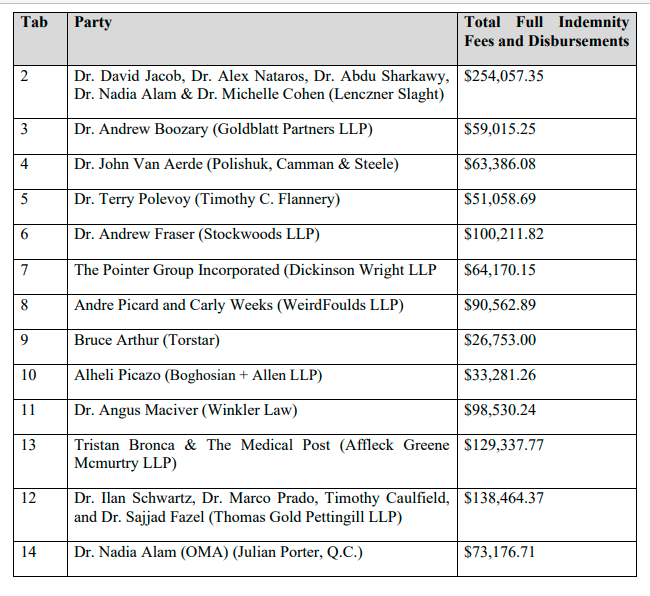
This was another headache Lamba had to deal with. The bulk of the lawsuit had nothing to do with her, but she was claiming damages against everyone. Once the case was thrown out, she was presumptively on the hook for half of it. Part of the reason Lamba and Gill got separate counsel is that their interests diverged greatly in terms of the costs.
Gill would benefit much more from a 50/50 split
Lamba would benefit from everyone paying their own share
Anyhow, this is only a quick summary. Do read the entire Statement of Claim, as it’s quite the eye opener.
What will happen with this lawsuit?
It’s hard to say, but here’s a personal prediction:
Since it’s a lawyer being sued for negligence and malpractice, insurance will likely cover it. This means they’ll be providing a lawyer to defend it, and pay most of the bills. If it were a claim for dishonesty or misrepresentation, they probably wouldn’t.
Anyhow, insurance companies are businesses, and they don’t like losing money. They may very well force a settlement, or leave the client to fend for himself. They also don’t like insuring high risk subjects.
LAMBA PROFESSIONAL MALPRACTICE CLAIM:
(1) Lamba Statement Of Claim
(2) Lamba Notice Of Intent To Defend
MOTION FOR SECURITY OF COSTS
(1) Gill V. Maciver Amended Notice of Motion – 26 Sept 2023
(2) Gill v Maciver – San Grewal’s appeal for support M54554.MPF.PointerGroup – October 2023.PDF
(3) https://drive.google.com/file/d/1PbEewt3dAKqAT5Udp6BIIqrM9Y_AhPHv/view
(4) Ruling: Motion For Security Of Costs – Denied
KULVINDER GILL/ASHVINDER LAMBA CASE:
(1) Gill/Lamba Defamation Lawsuit December 2020
(2) https://www.canlii.org/en/on/laws/stat/rso-1990-c-c43/latest/rso-1990-c-c43.html#sec137.1_smooth
(3) Gill/Lamba Factum Of Medical Post Tristan Bronca
(4) Gill/Lamba Case Dismissed As A SLAPP
(5) https://www.canlii.org/en/on/onsc/doc/2022/2022onsc1279/2022onsc1279.html#par17
(6) Gill/Lamba Notice of Appeal and Appellants’ Certificate
(7) Gill/Lamba Appeal – Notice of Intention to Dismiss Appeal for Delay, May 12, 2022
(8) Motion To Recuse – Badly Redacted -2022-06-17 – Notice
(9) Motion To Recuse – Badly Redacted -2022 – Motion Record
(10) Gill/Lamba July 15 Letter To Obtain New Counsel
(11) Gill/Lamba Case Conference Brief July 29, 2022
(12) Gill/Lamba Endorsement New Counsel Cost Submissions August 3, 2022
(13) Gill/Lamba Case $1.1 Million In Costs Ordered October 31, 2022
(14) Gill/Lamba Appeal Dismissed As Baseless By ONCA
(15) https://coadecisions.ontariocourts.ca/coa/coa/en/item/22116/index.do
GILL/ATTARAN/UNIVERSITY OF OTTAWA CASE:
(1) Gill-Attaran Statement Of Claim
(2) Gill Attaran Affidavit Of Service
(3) Gill-Attaran Notice Of Intent
(4) Gill-Attaran Motice To Recuse
(5) Gill-Ataran Motion To Recuse Motion Record

